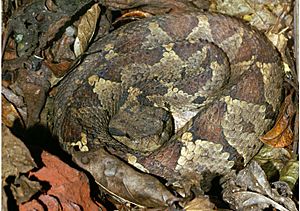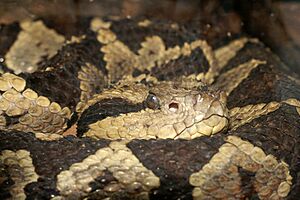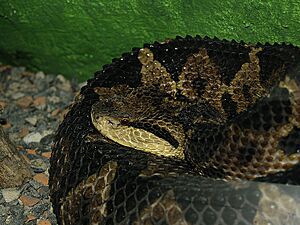Metlapilcoatlus mexicanus facts for kids
Quick facts for kids Metlapilcoatlus mexicanus |
|
|---|---|
 |
|
| Conservation status | |
| Scientific classification | |
| Genus: |
Metlapilcoatlus
|
| Species: |
mexicanus
|
| Synonyms | |
|
|
The Central American jumping pitviper (scientific name: Metlapilcoatlus mexicanus) is a type of venomous pitviper. This snake is found only in certain parts of Mexico and Central America.
About the Central American Jumping Pitviper
Adult jumping pitvipers usually grow to be about 50 to 70 centimeters (around 20 to 28 inches) long. That's roughly the length of a large ruler! The longest male snakes found were about 86.7 centimeters (34 inches). The longest females were even bigger, reaching up to 97.9 centimeters (38.5 inches). These snakes have a very thick and strong body.
Where These Snakes Live
You can find the Central American jumping pitviper in areas that drain into the Atlantic Ocean. Their home range stretches from Mexico, specifically in the states of Tabasco and Chiapas, all the way south to the Canal Zone in Panama. They also live on both sides of Costa Rica and Panama.
These snakes live at different heights, from about 40 meters (130 feet) to 1,600 meters (5,250 feet) above sea level. The first place where this snake was officially identified was in Cobán, which is in the Alta Verapaz region of Guatemala.
How Scientists Classify This Snake
Scientists like Campbell and Lamar (in 2004) consider Metlapilcoatlus mexicanus to be its own unique species.




